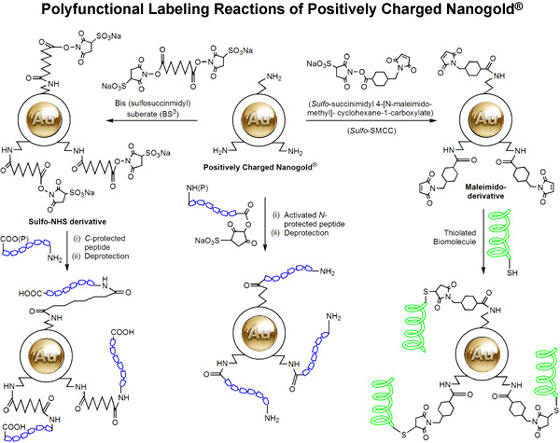If you want Multifunctional Gold…
While monofunctional gold is good for many things, it is not ideal for everyone, and people occasionally ask us whether we can attach many copies of something – usually a peptide or a small molecule – to one gold particle. As it happens, yes you can: you can use our Charged Nanogold® reagents. We offer two reagents: Positively Charged Nanogold®, which contains about 3 – 6 peripheral aliphatic amines, and Negatively Charged Nanogold®, which contains about 6 – 12 carboxylate groups on its outer surface.
Positively Charged Nanogold®, can participate in a number of different labeling reactions.
If the molecule you wish to conjugate has a carboxylic acid group (such as a C-terminal in a peptide), you can conjugate it to Positively Charged Nanogold using the reaction used in peptide synthesis: activate the carboxylic acid using EDC (1-Ethyl-3- [3-dimethylaminopropyl] carbodiimide hydrochloride) and Sulfo-NHS; you can purchase EDC from a number of sources. EDC reacts with a carboxyl group on the molecule to be labeled, forming an amine-reactive O-acylisourea intermediate. This intermediate is susceptible to hydrolysis, making it short-lived in aqueous solution. Addition of sulfo-NHS (5 mM) stabilizes the amine-reactive intermediate by converting it to an amine-reactive sulfo-NHS ester, increasing the efficiency of EDC-mediated coupling reactions. This activated sulfo-NHS ester then reacts readily with amino- groups.
Reference:
Staros, J. V.; Wright, R. W., and Swingle, D. M.: Enhancement by N-hydroxysulfosuccinimide of water-soluble carbodiimide-mediated coupling reactions. Anal. Biochem., 156, 220-222 (1986).
Alternatively, the amino- groups on Positively Charged Nanogold® may be activated using cross-linking reagents. Two examples are shown. In the first, the water-soluble homobifunctional cross-linking reagent bis (sulfo-succinimidyl) suberate (BS3) (link to http://www.piercenet.com/browse.cfm?fldID=02030212) is used for conjugation to the N-terminal of a peptide in which the C-terminal has been protected. One feature of this procedure is that it provides a relatively long link: the C8 chain of the BS3 is added to the propyl group which bears the amine, which projects beyond the outer surface of the ligand shell of the Nanogold® particle. In the second scheme, a water-soluble heterobifunctional cross-linker, sulfo-succinimidyl 4-[N-maleimido-methyl]-cyclohexane-1-carboxylate (Sulfo-SMCC) (link to http://www.piercenet.com/browse.cfm?fldID=02030378), is used to convert the amines to maleimide groups, which react selectively with thiols. The maleimido- derivative is then used to label a thiolated biomolecule, such as a cysteine-containing peptide. A variety of other cross-linkers may be used to link the amines to different functional groups; you can explore them with the Pierce cross-linker selection guide (link to http://www.piercenet.com/products/browse.cfm?fldID=26436A16-60A0-4A56-85F7-213A50830440).

|
| Reactions of Positively Charged Nanogold, comparing direct reaction with activated carboxylic acids vs. activation with cross-linkers for selective reaction with amines or thiols. |
With Negatively Charged Nanogold®, the usual activation method is to activate the carboxyl groups using the same reaction used for carboxylic acids labeled with amino- Nanogold®: reaction with EDC (1-Ethyl-3- [3-dimethylaminopropyl] carbodiimide hydrochloride) and sulfo-NHS; you can purchase EDC from a number of sources. EDC reacts with a carboxyl group, forming an amine-reactive O-acylisourea intermediate. This intermediate is susceptible to hydrolysis, making it unstable and short-lived in aqueous solution; therefore it is reacted with Sulfo-NHS (5 mM) to convert it to an amine-reactive sulfo-NHS ester, increasing the efficiency of EDC-mediated coupling reactions. This reaction is widely used in peptide synthesis; however, Nanogold®-labeled peptides should not be exposed to trifluoroacetic acid (TFA) during subsequent deprotection steps, and if Nanogold® labeling is conducted before deprotection, an alternative protective group to the commonly used tBoc should be used, such as Fmoc.

|
| Reactions of Negatively Charged Nanogold®, showing activation with EDC/Sulfo-NHS vs. activation with N,N'-carbonyldiimidazole. |
Another reagent that works well in non-aqueous systems, for example when labeling small organic-soluble molecules, is N,N’-carbonyl-diimidazole (CDI). The Negatively Charged Nanogold® should be dissolved in a small amount of the organic solvent (DMF or DMA) and excess CDI added; the pH is then raised to 7.5 or higher by the addition of aqueous reaction buffer, and the C-protected peptide or small molecule added.
Staab, H. A., and Rohr; W.; Newer Methods Prep. Org. Chem., 5, 61 (1968).
More information on Multifunctional Gold:
|
Also in this issue:
New Applications Articles:
|